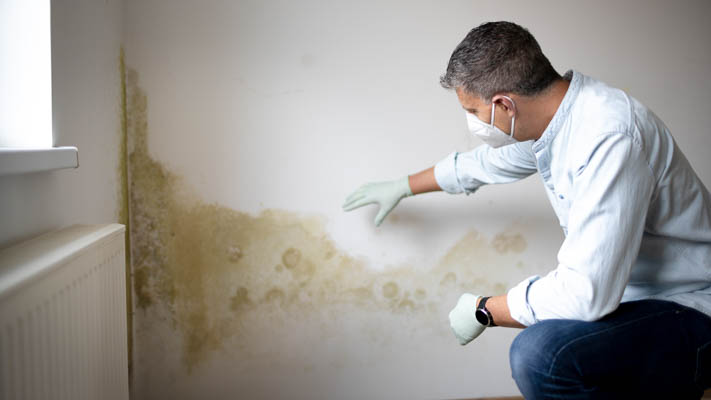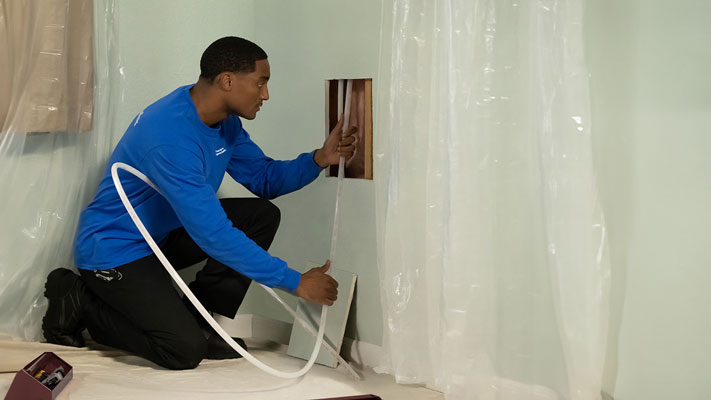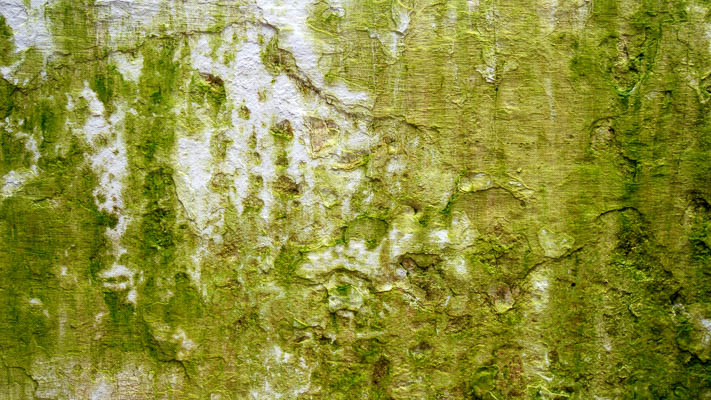What Does Mold From a Water Leak Look Like?
Mold caused by water leaks can take a few different forms. It often starts as small patches or discoloration and grows over time.
These patches may appear black, green, gray, or even orange, depending on the type of mold and the surface it's growing on. Black mold is one of the most common types and tends to show up in dark, damp corners, like behind cabinets, under sinks, or in basements.

It's not always obvious at first, especially if the mold is growing in corners or behind furniture. A lot of people also describe a damp, musty smell before they actually see anything. That earthy, "old basement" smell is a good early warning sign.
Common signs that mold is growing after a leak include:
- Dark, spotty discoloration on drywall, ceiling tiles, or baseboards
- Fuzzy or spongy textures on affected surfaces
- Persistent, musty odors near plumbing fixtures or behind walls
Spotting mold early is key. Once it takes hold, it can spread quickly and quietly.
How Can I Tell if It's Water Damage or Mold?
Water damage and mold often show up in the same places, but they do have some key differences.
Water damage usually shows as stains. They can be yellow, brown, or even rust-colored patches on the ceiling or wall. You might also see bubbling or peeling paint (which can also be a sign of mold), or warped materials like swollen baseboards or floorboards. If you touch it, the area might feel soft or spongy.
Mold, on the other hand, is more likely to be black, green, or white and can have a fuzzy or slimy texture. If you gently wipe it (with a glove or cloth), it'll often smear or come off like a stain. If it doesn't smear, it's probably just a water mark. If it does, mold is probably involved.
The smell is another big clue. Water damage doesn't usually smell, but mold does. If you catch a musty, sour, or earthy odor that doesn't go away, that's your nose telling you something's growing where it shouldn't be. There are several quick and easy ways to help detect a water leak in your house.
Can Mold Spread Behind Walls After a Water Leak?
The simple answer is: yes, and unfortunately, it happens more than most people realize. If a pipe leaks inside your wall, it creates a warm, damp, dark space that mold loves. Because it's hidden, it can keep spreading for weeks or even months before anyone notices.
You might not see the mold directly, but there are signs to look for. Peeling or bubbling paint, discolored drywall, or a strange smell near a wall could all point to hidden mold. In some cases, you might even notice the wall feels damp or sounds hollow when tapped.
Left unchecked, mold behind walls can damage insulation, drywall, and even wooden framing. Since mold releases airborne spores, it can also affect indoor air quality. This is especially pronounced for people with allergies, asthma, or other respiratory issues.
How Do I Stop Mold From Growing After a Leak?
Stopping mold after a leak means acting quickly and drying everything thoroughly—but it also means addressing the cause of the leak to prevent future problems. Mold can start to grow within just 24 to 48 hours of water exposure, so every step you take after discovering a leak counts.
Here's what to do:
- Fix the leak immediately: Whether it's a burst pipe or a small drip, any amount of water left to sit can invite mold. The first step is always to stop the source of moisture.
- Dry everything—fully and fast: Use fans, heaters, and dehumidifiers to dry wet areas. If insulation, drywall, or carpeting has absorbed water, it may need to be removed and replaced to prevent mold growth behind the surface.
- Disinfect and clean: Use mold-killing solutions like white vinegar or EPA-approved antimicrobial cleaners to sanitize any hard surfaces that got wet. Bleach isn't always effective on porous materials.
- Ventilate the area: Keep air moving with fans or by opening windows. In areas prone to humidity (like bathrooms and laundry rooms), use exhaust fans and consider installing a dehumidifier.
But here's the thing: Sometimes the leak you see is only part of the story. It may be that your home's plumbing has far exceeded its life expectancy.
Repiping Outdated Materials
In many homes, especially those built more than 20-30 years ago, outdated plumbing materials like polybutylene, galvanized steel, or even aging copper pipes can corrode or break down over time.
These materials are more prone to developing slow, hidden leaks inside walls or beneath floors. The kind of leaks that you might not notice until mold is already spreading.

If you've had more than one leak, or if mold keeps returning in different areas of your home, it might be time to consider a full home repipe. Replacing those outdated pipes with modern materials like Uponor PEX-A tubing can stop the cycle of hidden moisture and prevent mold from becoming a recurring issue.
Contact us to have one of our local repipe consultants explain your repipe options and provide you with a consultation and quote, either in-home or remotely.
Get your free estimate today
With over 75,000 repipes completed, we've perfected our One-Stop Repipe™ for your home.
Get a Quote for Repiping Your Home
Here at Repipe Specialists, we've permanently fixed leaking outdated pipes in thousands of homes by repiping them with PEX tubing. We continually receive positive customer feedback about their overall home repipe experiences and often exceed their expectations in the following areas:
- Speed: Our repipe crews typically complete a repipe in a day, returning on another day for wall patching.
- Convenience: Through our One-Stop Repipe™ Process, we handle everything from permits, to wall patching, to inspections.
- Cleanliness: Our crews are trained to protect your home while working (we cover all surfaces with protective sheeting), and to clean up fully at the end of each day.
- Peace of Mind: Repipe Specialists is a fully licensed plumber in every state we operate in, and we back all of our repipes with a lifetime warranty.
- Financing programs: To help take the sting out of unplanned repipe expenses, we offer several financing programs.
- Price: As a specialist that performs hundreds of repipes a week, we can deliver high quality repipes at a lower cost vs generalist plumbers. Our quotes typically range from $4,500 to $15,000 depending on the size and complexity of your project. We have an article that cover repipe cost factors in detail.
Schedule a free in-home consult, and one of our local repipe consultants will explain all your repipe options and provide you with a written, fixed-price quote. Fight mold, repipe outdated pipes.

